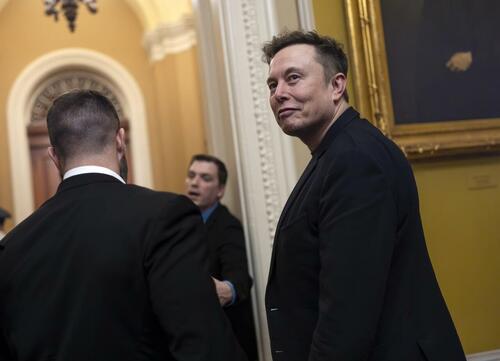
Мы знаем, как исправить правительство - будем ли мы?
Автор: J.Peder Zane via RealClearPolitics.com
Департамент эффективности правительства заметил загвоздку: кнопка входа на главной странице IRS была не там, где должна быть. Вместо верхнего правого угла, где мы, люди, были обучены искать логины, он был уложен другими кнопками в середине страницы. Найти его было несложно, но его необычное размещение нарушило интерфейс между налогоплательщиками и сборщиками налогов.

Это было простое решение.
Тем не менее, инженер IRS подсчитал, что для перемещения кнопки потребуется не менее 103 дней.
К счастью, команда Илона Маска опубликовала в прошлом месяце на X:
"Этот инженер работал с командой DOGE над удалением волокиты и Задание было выполнено за 71 минуту. "
Если DOGE что-то и раскрыла за первые 100 дней, так это глубину правительственной дисфункции. В то время как недоброжелатели Маска упиваются его наиболее очевидным недостатком - на сегодняшний день он сократил государственные расходы на 160 миллиардов долларов вместо обещанных 2 триллионов долларов - срочная необходимость в реформе очевидна. Трудность, с которой сталкиваются умные и целеустремленные экономаки при разборе насыпей федеральных отходов, — это канарейка, плачущая в угольной шахте.
Если взять любимое слово прогрессистов, то проблемы, с которыми мы сталкиваемся при неэффективности правительства, носят системный характер. Мошенничество и злоупотребления являются реальными проблемами, но, как показывает пример с кнопкой IRS, более глубокие проблемы связаны с тем, что проходит стандартную операционную процедуру. Мы создали левиафана, который душит нас процессом.
Фред Каплан приводит яркий пример в своей статье в New York Review of Books о Радже М. Шахе и новой книге Кристофера Кирхгоффа «Unit X: Как Пентагон и Силиконовая долина меняют будущее войны».
Как пишет Каплан, будучи капитаном ВВС США, Шах совершал полеты над Ираком в 2006 году, когда заметил, что экран его F16 не указывает его местоположение относительно координат на земле. Вернувшись в свои казармы, Шах загрузил карманный компьютер, который у него был для игры в видеоигры с цифровыми картами, и привязал его к колену, пока он летал. Программное обеспечение в этом гаджете за 300 долларов позволило ему увидеть, где он был - основная информация, которую гаджеты на его самолете за 30 миллионов долларов не могли предоставить. "
Десять лет спустя Шах возглавил небольшой стартап Пентагона Defense Innovation Unit Experimental (DIUx), который стремился применить инновации Силиконовой долины, такие как карманный ПК, к военным. Одной из первых задач была координация дозаправки самолетов в воздухе.
Каплан писал, что это «очень сложная задача... Тем не менее, чтобы спланировать эти операции, они перемещали магнитные шайбы на доске, как это делали их предки во время Второй мировой войны. "
Он продолжил: «Northrop Grumman выиграла контракт на капитальный ремонт этой системы; к тому времени, когда Шах увидел доску, компания потратила 745 миллионов долларов — вдвое больше первоначальной оценки — в течение десяти лет, и ВВС теперь просили Конгресс о большем. "
Каплан сообщает, что Шах связался с «небольшой фирмой из Силиконовой долины», которая разработала «рабочий продукт ... за четыре месяца, стоимостью 1,5 миллиона долларов». Излишне говорить, что они столкнулись с интенсивным сопротивлением со стороны офицера ВВС, управляющего программой Northrop Grumman, и со стороны сотрудников подкомитета Палаты представителей, контролирующих оборонный бюджет. К счастью, адвокат в руководстве Пентагона помог им «прорваться сквозь блокировку». "
Никто не знает, сколько проблем на 745 миллионов долларов можно решить с помощью решения на 1,5 миллиона долларов, но, похоже, можно с уверенностью предположить, что ответ на этот вопрос будет найден. много. Несмотря на то, что DOGE привлекла внимание к увольнению федеральных работников и закрытию нескольких правительственных программ, ее наиболее значительным вкладом было выявление потрясающих моделей отходов и неэффективности, которые раздувают размер и стоимость правительства.
Еще один пример: 21 марта DOGE сообщила, что «в IRS имеется объем транзакций банка среднего размера, управляющего аналогичной инфраструктурой. Эти банки, как правило, имеют бюджет операций и обслуживания (O & M) ~ 20 миллионов долларов в год. Налоговое управление США имеет бюджет O&M в размере ~ 3,5 млрд долларов США (который не включает дополнительный бюджет модернизации в размере 3,7 млрд долларов США)». Имейте это в виду, когда прочтете следующий пугающий заголовок о сокращении рабочих мест в Налоговом управлении США.
Ошибка неизбежна в человеческой деятельности. Дог, безусловно, допустил ошибки. Но большая ошибка заключается в том, что каждый государственный работник и правительственный контракт необходимы. Это неявный аргумент недоброжелателей Маска. Даже если бы это утверждение было правильным, наша нынешняя траектория расходов неустойчива. Что-то должно дать.
Тем не менее, есть основания для надежды. Вместо того, чтобы просто праздновать тех, кто нашел способ переместить кнопку домашней страницы за 71 минуту, давайте определим и устраним слои бюрократии, которые превратили бы это в 103-дневное испытание. Если разработчики программного обеспечения могут решить проблемы Пентагона по дешевке, давайте составим и аннулируем список глупо дорогих контрактов - прежде чем увеличивать свой годовой бюджет к северу от 1 триллиона долларов. Это можно сделать.
Эти усилия могут быть даже двухпартийными. Поскольку администрация Трампа предложила сократить финансирование научных исследований, его оппоненты утверждают, что это станет одной из самых сильных сторон Америки: нашей непревзойденной изобретательности и ноу-хау. Почему мы все не согласны использовать этот динамизм для создания правительства, столь же умного и эффективного, как наша нация?
Тайлер Дерден
Фри, 05/02/2025 - 17:40










